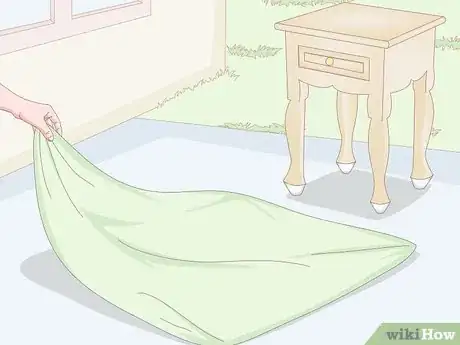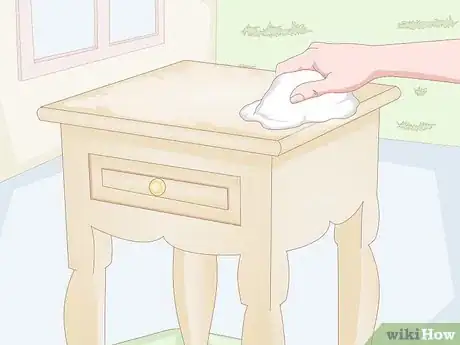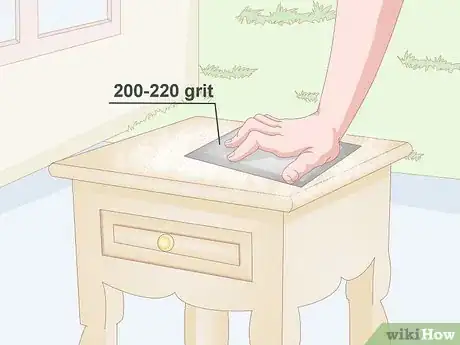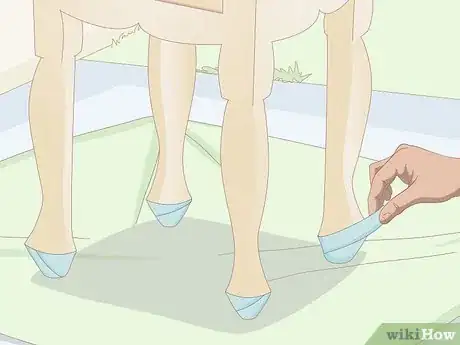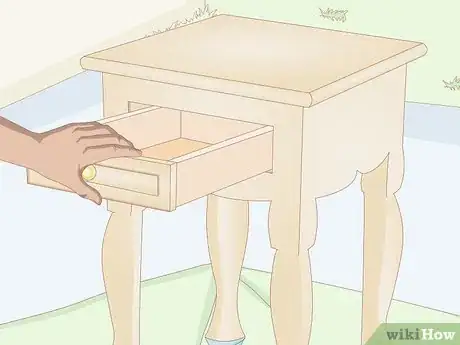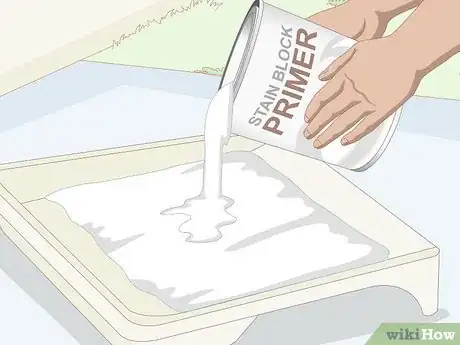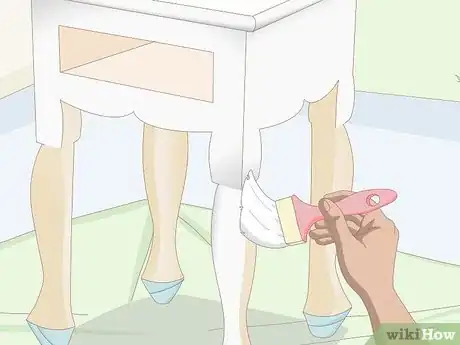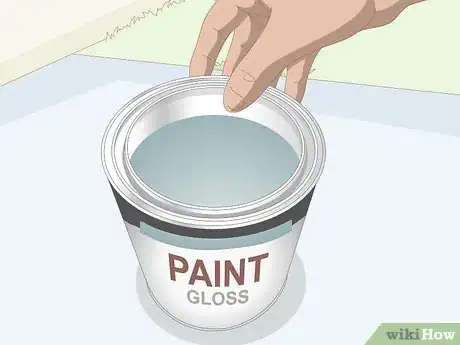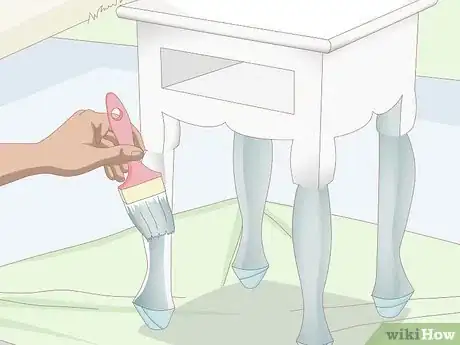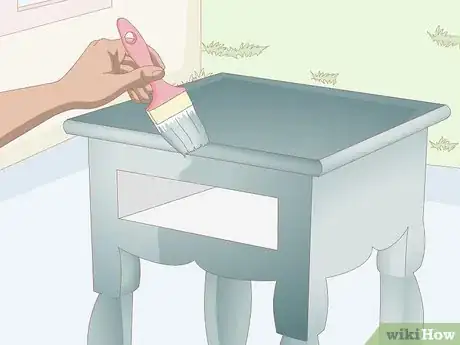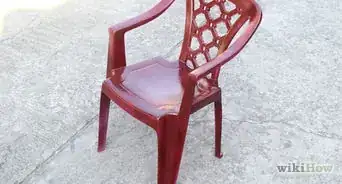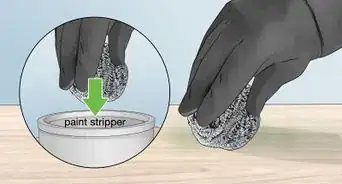This article was co-authored by Andres Matheu and by wikiHow staff writer, Eric McClure. Andres Matheu is the Owner of Hömm Certified Painting Systems, an Interior and Exterior Residential painting business based in the Washington, DC Metro area. Andres specializes in interior and exterior residential painting, color consultations, cabinet refinishing, wallpaper removal, and epoxy flooring among other services. An EPA Lead-safe Certified Firm, Hömm Certified Painting Systems has been awarded the Best of Houzz 2019 Service, Angie's List Super Service Award 2019, and Northern Virginia Magazine's 2018 Best Home Experts (painters) award.
This article has been viewed 28,079 times.
Before you paint pine furniture, sand it to remove the previous layers of finish while opening up the grain in the porous wood. Then, prime your furniture with a stain-resistant primer. After your furniture is sanded and primed, you can paint it with a brush and roller. Prevent damaging your floors by working over a drop cloth in a well-ventilated area. Always wear a dust mask when working with oil-based paints or primers, and protect your eyes, lungs, and hands while sanding by wearing protective eyewear, a dust mask, and gloves.
Steps
Cleaning and Sanding Your Furniture
-
1Set out a drop cloth or take your furniture outside. You’re going to make a little bit of a mess while sanding your wood and you don’t want any paint dripping on to your floor, so set out a large drop cloth underneath your furniture. If you’re painting a smaller item, feel free to take it outside so that you don’t need to worry about making a mess in your home.[1]
- If you paint your furniture outside on a windy day, you could end up with a lot of small pieces of dust, grass, or debris getting stuck in your paint. A windy day is excellent for sanding though.
-
2Clean your furniture with a damp cloth. Run a clean cloth or rag under warm water and wring it out over a sink or bucket to remove the excess water. Run the rag or cloth over every surface of your furniture to remove any dirt, debris, or splinters. Let the furniture air dry for at least 30-45 minutes.[2]
- If your pine is unfinished, wait 2-3 hours to give the moisture time to evaporate.
- You don’t need to scrub your furniture—it shouldn’t be soaking wet by the time that you’re done.
Advertisement -
3Sand your pine with 120-150 grit sandpaper. Purchase a sanding brick or attach a sheet of 120-150 grit sandpaper to a belt sander. Run your sandpaper firmly across every surface of your furniture to pull up the porous wood, remove debris and splinters, and make it easier to paint.[3] If you’re using a belt sander, guide it carefully over the furniture. If you’re using a sanding brick, use light back-and-forth strokes. Work in the direction of the grain.
- Unless you want a spongy, distressed look, you need to sand your furniture regardless of whether it is finished or unfinished.
- Stop after you’ve run the sandpaper over every section of the wood.
- Wear protective eyewear and gloves while doing this to prevent damaging your eyes or hands. Put on a dust mask before sanding to keep your lungs safe.
Tip: If you’re painting finished furniture, don’t worry about removing the paint. The goal is to soften the wood and expose the pores, not remove paint.
-
4Sand again using 200-220 grit sandpaper. Use the same method that you used to sand your furniture the first time to ensure that your wood grain remains uniform. Sand your furniture lightly with your brick or sander to remove smaller blemishes and smooth out minor scratches. Sanding twice will make it easier for the primer to bind with the wood, which will make the paint more uniform and permanent when you apply it.
- The finer sandpaper will also remove any wood dust that is sticking to your furniture after using the rougher sandpaper.
- You can stop sanding after you’ve run the sandpaper over each section of the furniture.
- Sanding with the finer paper will remove hard-to-see splinters and minor imperfections.
-
5Brush your furniture with a dry, clean paint brush. Wipe off the remaining wood dust and splinters by brushing your furniture with a standard paint brush that has never been used. Brush freely and firmly to wipe all of the debris on to the ground or drop cloth.
- You can wipe your furniture with a dry cloth or rag if you prefer.[4]
Priming Your Pine
-
1Tape off any handles or details that you want to stay dry. Use painter’s tape to cover any sections that you want to paint a different color or leave blank.[5] Place a piece of painter’s tape against the edge that you’re going to leave unpainted and press it down as you roll the tape along the edge. Press down on a strip of painter’s tape to ensure that the adhesive is smoothed out against the wood.[6]
- If you have metal handles or leg covers, they can usually be removed with a screwdriver.
- Paint can bleed through the edge of painter’s tape. Use it as a guide, not a perfect safety measure.
-
2Remove any drawers or shelves to make painting easier. If you’re painting a dresser, end table, or armoire, remove the drawers or shelves so that you don’t need to worry about paint dripping in between spaces in the wood. It is easier to paint these removable pieces separately, and removing them will prevent you from missing hard-to-reach areas between gaps.[7]
- You don’t need to prime, sand, or paint the areas that aren’t going to be visible.
- You can paint and prime drawers and shelves on a set of saw horses or separate section of your drop cloth.
-
3Fill a paint tray with a stain-blocking primer. Unscrew or pry the lid off of your primer and fill a paint tray with 1⁄2–3⁄4 gallon (1.9–2.8 L). If you plan on using latex paint, use a latex primer. If you’re going to use an alkyd or oil-based paint, use a primer that uses the same base as the paint. Read a label before purchasing a primer to make sure that it is stain-blocking for the best results.[8]
- Wear a respirator or dust mask if you’re working with oil-based primer. The fumes are a lung irritant.
- Open a window before pouring your primer if you’re working indoors. Even nontoxic latex primers can smell obnoxious in a closed room.
Warning: Pine is a tannin-rich wood, which means that it can resist paint fairly well. Because pine is so strong, you absolutely cannot skip the priming process. Your paint job will not be uniform or clean if you don’t prime your wood.
-
4Roll larger surface areas with a thin-napped mini-roller. Use a 6 in (15 cm) foam roller to cover larger surfaces of your furniture. Submerge your roller in the paint and then roll it 2-3 times in the tray to remove excess paint. Use light pressure to roll up and down across the flat surfaces. Roll 2-3 times over an area to ensure that you get primer on every section of your furniture. A medium-sized dresser should require roughly 0.5 gallons (1.9 L) of paint.[9]
- It can be really hard to remove oil-based primer from a roller. You may be better off not wasting your time trying to clean it and toss it out. You can also wrap it in a plastic bag to keep it wet if you want to apply multiple layers.
- For rougher pine, use a thick-napped roller instead.
- You can use a larger roller if your furniture is larger.
-
5Brush intricate details, curves, and smaller surfaces with a natural brush. Use an angled or flat brush with natural bristles to paint details, curves, or hard-to-reach areas of your furniture. Use back-and-forth strokes to cover each area of your furniture. Paint in the direction of the wood grain whenever possible.[10]
- Leave no visible surface unprimed. It’s okay if the coat of primer isn’t perfectly even in color—especially if you’re using a gloss paint—but every surface should be primed.
- Use your brush to work around any handles or edges of painter’s tape.
- Avoid drips by brushing with light pressure and allowing your brush to move in your wrist as you paint.
-
6Wait 12-24 hours for your primer to dry. If you paint your pine furniture before the primer has a chance to fully dry into the wood, you’ll end up with an uneven paint job and an unprotected piece of furniture. Let your furniture air dry in a low-moisture environment with plenty of access to air.[11]
Painting Furniture with a Brush and Roller
-
1Choose a color and style of paint. Select your color based on your personal preferences. Choose between a gloss, semi-gloss, or flat paint. You can use oil-based, alkyd or latex paint. If you’re painting a furniture item that you touch frequently, like a dresser or table, choose an alkyd-based paint. Latex paint will rub off more easily over time, especially if the furniture is being used regularly. For decorative pieces, latex will hold up just fine.[12]
- If you’re painting kitchen or bathroom cabinets, use an oil-based paint. It will resist moisture more efficiently than an alkyd or latex paint.
- If you want a distressed look and you use the furniture regularly, go ahead and use a latex paint. It will wear away and reveal the grain underneath over time.
-
2Fill a paint tray with 1⁄2–3⁄4 gallon (1.9–2.8 L) of paint. Open your can of paint with a flathead screwdriver by prying the lid off with the screwdriver’s head. Use a mixing stick to mix the paint until the color is uniform and even. Use both hands to hold the can over your paint tray and tilt it so that the paint pours into the tray. Use your brush to wipe the drips on the paint can away.
- Do this over your drop cloth or while you’re outside. Paint can drip down the side of the canister, so be careful.
-
3Paint angles, curves, or rough edges with a natural angle brush. Dip the tip of your brush into your paint tray and then tap it on the dry slope to remove excess paint. Use back-and-forth strokes to cover any angles, curves, edges, or hard-to-reach areas with paint. Run your brush over an area 3-4 times to ensure that the paint gets into the wood grain.[13]
- You can use a brush to paint the entire piece of furniture if you’d like. A roller will be easier to use and will result in more a more consistent look when it comes to larger, flat surfaces though.
- Depending on the size of your furniture, you can use a 3⁄4–3 in (1.9–7.6 cm) brush.
-
4Roll larger surfaces with a 6 in (15 cm) roller. Use a foam roller if you’re painting unfinished pine. If you’re painted previously-finished wood, use a roller with 1⁄4 in (0.64 cm) nap. Dip your roller in the paint tray and roll it in the bed to remove excess paint. Roll your furniture in the direction of the grain, starting from the top and working your way down. Cover each surface 2-3 times to make sure that you don’t miss any indentations or grooves in the wood.[14]
- If your piece of furniture is really big, feel free to use a standard 9 in (23 cm) roller.
- If the wood is really rough or has a lot of scratches in it, try using a roller with a thicker nap.
-
5Apply additional coats based on how dark and uniform you want the paint to be. The more coats of paint that you apply, the darker and more uniform your paint job will be. If you want a more rustic, distressed look, you can stop after 1 coat of paint. For a standard look, apply 2-3 coats. Wait 6-12 hours between coats to ensure that the previous layer has fully dried.[15]
- Sand lightly in between coats if you have any drips or blemishes that you want to cover.
-
6Apply a protective finish if you want to preserve your paint job. If you’re happy with the look and feel of your painted furniture, you can stop after you’ve painted it. If you want to protect the paint, add a layer of polycrylic protective finish. Use a natural-bristle brush and a small foam roller to cover every surface of your furniture. Wait 72 hours to give the finish enough time to fully settle.[16]
- The finish won’t change the color of the paint job, but if you get a glossy version of the finish, it could make your furniture more reflective.
- If you don’t wait at least 3 days before using or touching your furniture, it will be sticky and you could risk ruining the finish.
Tip: Polycrylic protective finishes come in liquid or spray form. You can use the spray version of the product if you’d like to get a stippled texture on your furniture.
Expert Q&A
-
QuestionDo you have to sand pine furniture before painting?
 Andres MatheuAndres Matheu is the Owner of Hömm Certified Painting Systems, an Interior and Exterior Residential painting business based in the Washington, DC Metro area. Andres specializes in interior and exterior residential painting, color consultations, cabinet refinishing, wallpaper removal, and epoxy flooring among other services. An EPA Lead-safe Certified Firm, Hömm Certified Painting Systems has been awarded the Best of Houzz 2019 Service, Angie's List Super Service Award 2019, and Northern Virginia Magazine's 2018 Best Home Experts (painters) award.
Andres MatheuAndres Matheu is the Owner of Hömm Certified Painting Systems, an Interior and Exterior Residential painting business based in the Washington, DC Metro area. Andres specializes in interior and exterior residential painting, color consultations, cabinet refinishing, wallpaper removal, and epoxy flooring among other services. An EPA Lead-safe Certified Firm, Hömm Certified Painting Systems has been awarded the Best of Houzz 2019 Service, Angie's List Super Service Award 2019, and Northern Virginia Magazine's 2018 Best Home Experts (painters) award.
Commercial Painter It’s always a must to sand furniture slightly at the least. Sanding will help you make sure the furniture is clean. It can also enhance the paint's adherence to the furniture, as it will open the pores of the wood. If you skip this step, there is a risk that the coat will fail, so it's always best to sand prior to painting.
It’s always a must to sand furniture slightly at the least. Sanding will help you make sure the furniture is clean. It can also enhance the paint's adherence to the furniture, as it will open the pores of the wood. If you skip this step, there is a risk that the coat will fail, so it's always best to sand prior to painting.
Things You’ll Need
- Protective eyewear
- Dust mask or respirator
- Thick gloves
- Painter’s tape (optional)
- Drop cloth
- Rag or cloth
- Belt sander or sanding block
- Paint tray
- Natural brush
- Angle brush
- Roller
- Paint
- Primer
- Finish
References
- ↑ https://www.bobvila.com/articles/30124-dream-it-do-it-how-to-paint-wood-furniture/
- ↑ https://www.bobvila.com/articles/30124-dream-it-do-it-how-to-paint-wood-furniture/
- ↑ Andres Matheu. Commercial Painter. Expert Interview. 28 July 2020.
- ↑ Andres Matheu. Commercial Painter. Expert Interview. 28 July 2020.
- ↑ Andres Matheu. Commercial Painter. Expert Interview. 28 July 2020.
- ↑ https://www.familyhandyman.com/painting/tips/using-masking-tape-when-painting/
- ↑ http://thenester.com/2010/08/painting-pine-furniture.html
- ↑ https://www.bobvila.com/articles/best-paint-to-use-on-wood/
- ↑ https://www.bobvila.com/articles/30124-dream-it-do-it-how-to-paint-wood-furniture/
- ↑ https://www.countryliving.com/diy-crafts/tips/a266/paint-furnishings-and-learn-from-my-mistakes/
- ↑ https://www.countryliving.com/diy-crafts/tips/a266/paint-furnishings-and-learn-from-my-mistakes/
- ↑ https://www.bobvila.com/articles/best-paint-to-use-on-wood/
- ↑ https://www.countryliving.com/diy-crafts/tips/a266/paint-furnishings-and-learn-from-my-mistakes/
- ↑ https://www.countryliving.com/diy-crafts/tips/a266/paint-furnishings-and-learn-from-my-mistakes/
- ↑ https://www.countryliving.com/diy-crafts/tips/a266/paint-furnishings-and-learn-from-my-mistakes/
- ↑ https://www.countryliving.com/diy-crafts/tips/a266/paint-furnishings-and-learn-from-my-mistakes/
